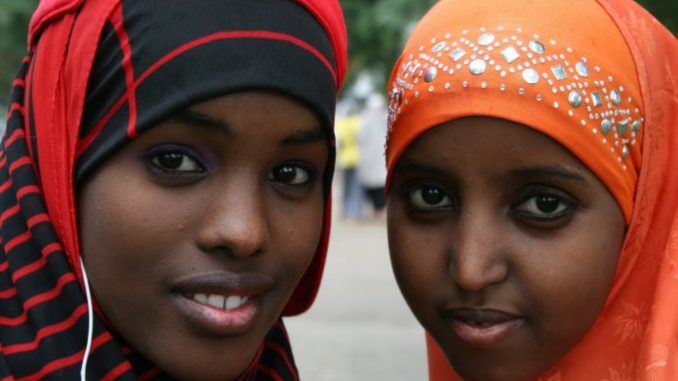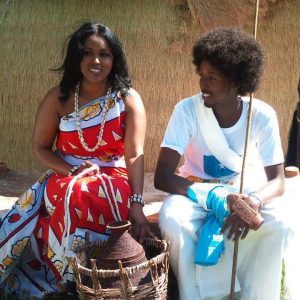
The Somali people, also known as Somalis (Somali: Soomaaliyeed, Arabic: الصوماليون), are an amalgamated clans of ancient nomadic and warrior Cushitic Somali-speaking ethnolinguistic group inhabiting the Horn of Africa popularly known as Somali Peninsula. Somalis who are known for being the most homogeneous people in Africa and in the world are predominantly Sunni Muslims and they have mixed over the years with Arab settlers. They reside in Somalia, Ethiopia, Kenya and Djibouti.
Ethnic Somalis population numbering over 18 million, with the larger concentration of over 8 million people living in Somali, over 4 million in Ethiopia, almost 1 million in Kenya and close to 500,000 in Djibouti; and with many also residing in parts of the Middle East, North America and Europe.

The Somalis are ancient indigenous people who originated from a common ancestor, Irir Samaale (Irir Samali) who migrated from the highlands of Ethiopia and is probably of Ethiopian Cushitic Oromo ethnicity. Samaale is generally regarded as the source of the ethnonym Somali. It is believed that the nomadic Somali people existed in Ethiopia long before the prehistoric paintings on the cave of Laas Gaal in Somalia were ever made and that Irir Samale – possibly a nomadic man who came from a nomadic Ethiopian tribe – migrated to Somalia.
It is therefore not true as asserted by pro-Arabic historians and is recorded in Shariif ‘Aydaruus Shariif ‘Ali’s Bughyat al-amaal fii taariikh as-Soomaal (1955), that the patriarch Samaale arrived in northern Somalia from Yemen during the 9th century and subsequently founded the eponymous Somali ethnic group. Fortunately where history falls short and is subjected to different twisted angles, advancement in science provides the missing links. Paleoanthropological evidence indicates that both the Levantine corridor and the Horn of Africa served, repeatedly, as migratory corridors between Africa and Eurasia and as a result there was interbreeding between them hence some Eurasia (Semitic-Arab settlers) features among the Somalis.
The recent genetic studies aiding the indigenous claim of Somalis as one of the African Cushitic ethnic group shows that 80% of the genes of Horn of Africans are indigenous and found only among themselves. According to Y chromosome studies by Sanchez et al. (2005) and Cruciani et al. (2004), the Somalis are paternally closely related to certain Ethiopian groups, particularly Cushitic speakers:
“The data suggest that the male Somali population is a branch of the East African population − closely related to the Oromos in Ethiopia and North Kenya −with predominant E3b1 [now “E1b1b1”] cluster lineages… and that the Somali male population has approximately 15% Y chromosomes from Eurasia and approximately 5% from sub-Saharan Africa.
Besides comprising the majority of the Y DNA in Somalis, the E1b1b1a (formerly E3b1a) haplogroup also makes up a significant proportion of the paternal DNA of Ethiopians, Sudanese, Egyptians, Berbers, North African Arabs, as well as many Mediterranean and Balkan Europeans. The M78 subclade of E1b1b is found in about 77% of Somali males,which, according to Cruciani et al. (2007), may represent the traces of an ancient migration into the Horn of Africa from Egypt/Libya. After haplogroup E1b1b, the second most frequently occurring Y DNA haplogroup among Somalis is the Eurasian haplogroup T (M70),which is found in slightly more than 10% of Somali males. Haplogroup T, like haplogroup E1b1b, is also typically found among populations of Northeast Africa, North Africa, the Near East and the Mediterranean.
According to mtDNA studies by Holden (2005) and Richards et al. (2006), a significant proportion of the maternal lineages of Somalis consists of the M1 haplogroup, which is common among Ethiopians and North Africans, particularly Egyptians and Algerians. M1 is believed to have originated in Asia, where its parent M clade represents the majority of mtDNA lineages (particularly in India). This haplogroup is also thought to possibly correlate with the Afro-Asiatic language family:
“We analysed mtDNA variation in ~250 persons from Libya, Somalia, and Congo/Zambia, as representatives of the three regions of interest. Our initial results indicate a sharp cline in M1 frequencies that generally does not extend into sub-Saharan Africa. While our North and especially East African samples contained frequencies of M1 over 20%, our sub-Saharan samples consisted almost entirely of the L1 or L2 haplogroups only. In addition, there existed a significant amount of homogeneity within the M1 haplogroup. This sharp cline indicates a history of little admixture between these regions. This could imply a more recent ancestry for M1 in Africa, as older lineages are more diverse and widespread by nature, and may be an indication of a back-migration into Africa from the Middle East.”
Another mtDNA study indicates that:
“Somali, as a representative East African population, seem to have experienced a detectable amount of Caucasoid maternal influence… the proportion m of Caucasoid lineages in the Somali is m = 0.46 [46%]… Our results agree with the hypothesis of a maternal influence of Caucasoid lineages in East Africa, although its contribution seems to be higher than previously reported in mtDNA studies.”
Overall, these genetic studies conclude that Somalis and their fellow Ethiopian and Eritrean Northeast African populations represent a unique and distinct biological group on the continent:
“The most distinct separation is between African and non-African populations. The northeastern-African — that is, the Ethiopian and Somali — populations are located centrally between sub-Saharan African and non-African populations… The fact that the Ethiopians and Somalis have a subset of the sub-Saharan African haplotype diversity — and that the non-African populations have a subset of the diversity present in Ethiopians and Somalis — makes simple-admixture models less likely; rather, these observations support the hypothesis proposed by other nuclear-genetic studies (Tishkoff et al. 1996a, 1998a, 1998b; Kidd et al. 1998) — that populations in northeastern Africa may have diverged from those in the rest of sub-Saharan Africa early in the history of modern African populations and that a subset of this northeastern-African population migrated out of Africa and populated the rest of the globe. These conclusions are supported by recent mtDNA analysis (Quintana-Murci et al. 1999)
The culture of Somalia is an amalgamation of traditions developed independently and through interaction with neighbouring and far away civilizations, such as other parts of Northeast Africa, the Arabian Peninsula, India and Southeast Asia.
The textile-making communities in Somalia are a continuation of an ancient textile industry, as is the culture of wood carving, pottery and monumental architecture that dominates Somali interiors and landscapes. The cultural diffusion of Somali commercial enterprise can be detected in its cuisine, which contains Southeast Asian influences. Due to the Somali people’s passionate love for and facility with poetry, Somalia has often been referred to by scholars as a “Nation of Poets” and a “Nation of Bards” including, among others, the Canadian novelist Margaret Laurence.
All of these traditions, including festivals, martial arts, dress, literature, sport and games such as Shax, have immensely contributed to the enrichment of Somali heritage.
BY: Kweku Darko Ankrah
